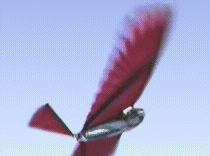Ornithopter facts for kids
An ornithopter is a special kind of aircraft that flies by flapping its wings, just like birds, bats, or insects. Designers try to copy how these amazing creatures fly. Even though ornithopters can look very different, they are often built to be about the same size as the animals they imitate.
People have also built ornithopters big enough for a person to fly, and some of them have actually worked! These machines usually come in two main types: those that use an engine to flap their wings, and those that rely on the pilot's own muscle power.
Contents
What is an Ornithopter?
An ornithopter gets its name from ancient Greek words. "Ornithos" means "bird," and "pteron" means "wing." So, an ornithopter is literally a "bird-wing" machine. Unlike airplanes that use fixed wings and propellers or jets, ornithopters move their wings up and down to create both lift (to stay in the air) and thrust (to move forward).
This way of flying is called flapping-wing flight. It's a very efficient way to fly in nature, allowing creatures to hover, dart, and glide with incredible control. Engineers and inventors have been fascinated by this for centuries, trying to unlock its secrets.
How Do Ornithopters Fly?
Ornithopters work by moving their wings in a complex way that pushes air downwards and backwards. This creates the forces needed for flight. When the wings flap down, they push air down, which lifts the aircraft. When they flap forward, they push air backward, which moves the aircraft forward.
The shape and movement of the wings are very important. They often twist and change shape during the flap cycle, much like a bird's wing. This helps them catch the air just right. Building a machine that can do this smoothly and powerfully is a big challenge!
A Look Back: History of Flapping Flight
People have dreamed of flying like birds for a very long time. One of the most famous thinkers to design an ornithopter was Leonardo da Vinci in the late 1400s. He drew detailed plans for machines with flapping wings, showing how much he studied birds. His designs were never built in his time, but they showed a deep understanding of flight.
In the 1800s and early 1900s, many inventors tried to build working ornithopters. People like Otto Lilienthal, who was famous for his glider flights, also experimented with flapping-wing machines. These early attempts often faced problems with power and control, but they taught engineers a lot about aerodynamics.
Early Designs and Challenges
Building an ornithopter is much harder than building a fixed-wing airplane. The main challenges include:
- Power: It takes a lot of energy to flap wings powerfully enough to lift a machine and keep it flying.
- Weight: The engine or pilot, along with the wing-flapping mechanisms, can make the aircraft very heavy.
- Control: Making the wings flap in a way that allows the pilot to steer and stay stable is very complex.
- Efficiency: Designing wings that can flap efficiently without wasting too much energy is a key goal.
Despite these challenges, inventors kept trying. Some early models were able to make short hops or flights, proving that the idea was possible.
Modern Ornithopters
Today, ornithopters are still being developed, often for specialized uses. While they haven't replaced traditional airplanes for travel, they are very useful for research and specific tasks.
Small and Robotic Ornithopters
Many modern ornithopters are small, unmanned robots. These tiny machines can be used for:
- Spying: Their bird-like appearance can help them blend in.
- Exploration: They can fly into tight spaces or dangerous areas.
- Research: Scientists use them to study how insects and birds fly.
- Surveillance: They can monitor areas without being easily noticed.
These small ornithopters often use tiny electric motors and advanced materials to make them light and strong. They can be very quiet and agile, making them perfect for delicate tasks.
Human-Powered Ornithopters
Some inventors still work on ornithopters that are powered by a human pilot. These are often built for competitions or to push the limits of human strength and engineering. Pilots pedal or use other body movements to flap the wings. Achieving sustained flight in a human-powered ornithopter is a huge accomplishment, requiring both a strong pilot and a very light, efficient design.
The Future of Flapping Flight
The study of ornithopters helps us understand more about how nature flies. This field, called biomimicry, is about learning from nature to solve human problems. As technology improves, we might see more ornithopters used for different purposes, especially in areas where quiet, agile flight is needed. They could help with environmental monitoring, search and rescue, or even delivering small packages.
Images for kids
-
Leonardo da Vinci's ornithopter design
-
Otto Lilienthal on August 16, 1894 with his kleiner Schlagflügelapparat
See also
 In Spanish: Ornitóptero para niños
In Spanish: Ornitóptero para niños









